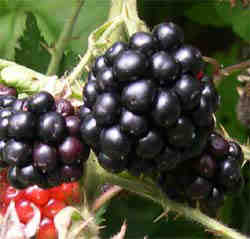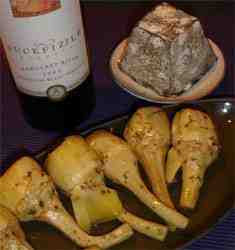Blackberry and apple jelly best recipe
Posted by Fiona Nevile in Jam Jelly and Preserves | 85 comments
Fat juicy blackberries in our garden
Try and pick the blackberries when the sun has been on them; midday is ideal. For the apples, we use windfalls because they are bruised and will not keep even though they might look perfect. Blackberry and apple jelly is sometimes referred to as hedgerow jelly.
If this is the first time that you have made jelly, check out the tips and tricks below, as some of the terms are a bit quirky. Making jelly is easy, you can cook the fruit one evening and make the jelly the next. (Generally, with jam and chutney, the whole procedure has to be done in one sitting).
We also have an old family recipe for blackberry and apple jam here.
You will need a heavy bottomed saucepan or Maslin pan.
Recipe for Blackberry and Apple Jelly
Ingredients:
- 2lbs/900gms of apples (windfalls or any apples are fine for this recipe)
- 2lbs/900gms of blackberries
- water (see method below)
- White granulated sugar (the amount depends on the volume of juice extracted from the simmered, drained fruit. Ipt/500ml of juice to 1lb/454gms of sugar. I always make sure that I have a 2 kilo bag of sugar in the larder, just in case I fancy making jelly).
Method:
- Wash the apples, cut out bruised bits and chop roughly. There is no need to peel and core the apples.
- Pick over the blackberries, reject any that are tatty and remove any stalks.
- Place fruit in a large deep heavy bottomed saucepan, or preserving pan. Add water to cover ½ of the fruit.
- Bring slowly to the boil and simmer very gently until all the fruit is soft and squishy. This takes about 15 minutes, depending on how ripe the fruit is.
- Pour the cooked fruit into a jelly bag and leave to drip into a bowl overnight. (What is a jelly bag? See tips and tricks below). This is traditionally a piece of sterilised muslin. (How do I sterilise muslin? See tips and tricks below). We use tall buckets to catch the drips from the jelly bags. Rather than hang the bags (conventional method) I find it easier to line a large plastic sieve with the muslin. This clips neatly onto the top of a clean bucket. The sieve is covered with a clean tea cloth to protect against flies.
- The next day, measure the extracted fruit juice and pour it into a deep heavy bottomed saucepan. Add 454g/1lb of white granulated sugar for each 570ml/1 pt of juice. Try to avoid squeezing the jelly bag as this can make the jelly cloudy.
- Heat the juice and sugar gently, stirring from time to time. Make sure that that all the sugar has dissolved before bringing the liquid slowly to the boil. Continue to boil hard for about 5-10 minutes before testing for a set. (What is testing for a set? See tips and tricks below). If the jelly hasn’t set, continue to boil and teat for a set at three minute intervals. Occasionally a jelly or jam will set very quickly, when this occurs you will notice that the sides of the pan have a coating of jelly and the back of the spoon is coated too. If you spot this, remove the pan from the heat immediately and test for set.
- Toss in a nugget of butter towards the end to reduce the frothing that often occurs.
- When jelly has reached setting point pour into warm sterilised jars using a funnel and ladle. (How do I sterilise jars? See tips and tricks below).
- Cover immediately with plastic lined screw top lids or cellophane tops secured with a rubber band.
- Label when cold and store in a cool, dark place. Away from damp.
Tips and tricks:
- What is a jelly bag?
A jelly bag is traditionally a piece of muslin but it can be cheesecloth, an old thin tea cloth or even a pillowcase. The piece needs to be about 18 inches square. When your fruit is cooked and ready to be put in the jelly bag, lay your cloth over a large bowl. Pour the fruit into the centre of the cloth and tie the four corners together so that they can be slung on a stick to drip over the bowl. Traditionally a stool is turned upside down, the stick is rested on the wood between the legs and the jelly bag hangs over the bowl. We experimented and now line a sieve with muslin, place it over a bucket and cover the lot with clean tea cloths (against the flies). - How do I sterilise muslin/the jelly bag?
Iron the clean jelly bag with a hot iron. - How do I remove stains from the jelly bag?
Your jelly bags can also look like new, after you’ve used them. When drained, remove the fruit and put it in the compost bin. Rinse the fruit residue from the cloth with cold water. Put the in a saucepan, cover it with cold water and a good dash of washing powder. Bring the saucepan slowly to the boil. Turn off when boiling point is reached and when cold rinse out well. Magically all stains will have disappeared! - Jam “set” or “setting point”:
Getting the right set can be tricky. I have tried using a jam thermometer but find it easier to use the following method. Before you start to make the jam, put a couple of plates in the fridge so that the warm jam can be drizzled onto a cold plate (when we make jam we often forget to return the plate to the fridge between tests, using two plates means that you have a spare cold plate). Return the plate to the fridge to cool for approx two minutes. It has set when you run your finger through it and leave a crinkly track mark. If after two minutes the cooled jam is too liquid, continue to boil the jam, testing it every few minutes until you have the right set. The jam is far more delicious if it is slightly runny. - Sterilising the jars:
We collect jars all year round for our jelly, chutney and jam making sessions. I try to soak off labels and store the clean jars and metal plastic coated screw-top lids in an accessible place. The sterilising method that we used is simple. Just before making the jam, I quickly wash and rinse the jars and place them upside down in a cold oven. Set the temperature to 160c/140c for fan assisted. When the oven has reached the right temperature I turn off the heat. The jars will stay warm for quite a while. I only use plastic lined lids for preserves as the all-metal lids can go rusty. I boil these for five minutes in water to sterilise them. If I use Le Parfait jars, I do the same with the rubber rings.
Leave a reply






Hi, I started making Blackberry and Apple jelly yesterday from frozen blackberries collected last month and my home grown cooking apples.(I’m a complete newbie and I have never done any preserving before).
I used 1kg of each fruit with enough water to cover half of it. Heated untill if all turned to mush and then left it overnight to drip through muslin. This morning I collected the juice and only managed to get 1 pint off. Is this right as it doesn’t seam alot considering the starting weights? Will finish off jelly later. Also can I just use normal granulated or is it best to use preserving sugar because of low pectin of blackberries? Sorry so long winded!
Am making a batch of haw,elderberry,crab apple and blackberry jelly tomorrow.Will use lemon juice as you stated if taste is not great although based on last years might not need it. Will let you know how it turns out!
Discovered your marvellous recipe after leafing through old cookery books – what a relief!
Just what I needed and the jelly absolutely delicious. I was amazed to find so many blackberries for free on the common near my home.
Thanks for the jelly recipe – I made it last night and it was fabulous. I shall be trying the damson cheese recipe before the fruit flies take over my fridge too!
Hi Amanda,
I am so pleased that you are enjoying the site.
We have quite a few jelly recipes using apples:
Sloe and Bramley Jelly
Rosehip and apple jelly
Old fashioned apple jelly
and Francoise’s Herb Jelly
Blackberry and Apple Jelly is my favourite.
Thanks for leaving a comment.
I’ve just found your website, which is fabulous & can’t wait to try more of your recipes.
Last night I finished making your Blackberry & Apple Jelly for Christmas Presents. It tastes absolutely wonderful & have decided to go out again at the weekend to find more blackberries as
I have loads of apples left over & want to make more. That’s if I don’t find another one of your recipes to make with the left over apples.
Keep up the wonderful website.
Amanda
Hi BizzyLizzy,
Blackberry and apple jelly keeps for at least a year unopened. Opened, it is at its best for about a month, kept in the fridge. These are both conservative estimates.
We have a wonderful damson chutney that we developed last autumn that is well worth making
There is also damson cheese which is great too
Lucky you having a glut of damsons. I have not found many this year and will be making our recipes with wild plums!
How long will the Blackberry and apple jelly keep unopened and opened. I love reading your recipies, so far have made damson gin, damson vodka, damson jam. My daughter has 5 damson trees and I can’t bear to see them going to waste, any more tips – I’ve run out of space in the freezer. Thanks, Bizzylizzy
Hi LizO,
We did this the first year we tried making jelly with a basket of fruit gathered in the garden – a couple of apples, a few blackberries, a pear and some rosehips as far as I can remember. It was very sweet and didn’t taste of anything much but we were delighted with it and christened it Estate Jelly. Now we go for a bit more flavour.
The sloes would be a good addition and give depth. Taste the juice before making the jelly, if it’s really sweet some fresh lemon juice will enhance the flavours. I’d love to hear how it turns out.
Hi
I am so pleased to have found the Cottage Smallholder site with so many wonderful recipes. I have a bag of windfall Lord Lamborn apples which I am hoping to combine with rosehips and blackberries, as well as a few sloes, as I couldn’t find enough of any of these individually. Do you think this will be alright. I’ll let you know how it tastes tomorrow when I cook up the jelly, having strained the fruit overnight tonight.
Thanks again for all the great ideas
LizO :o) (or :o( if it tastes bad!)